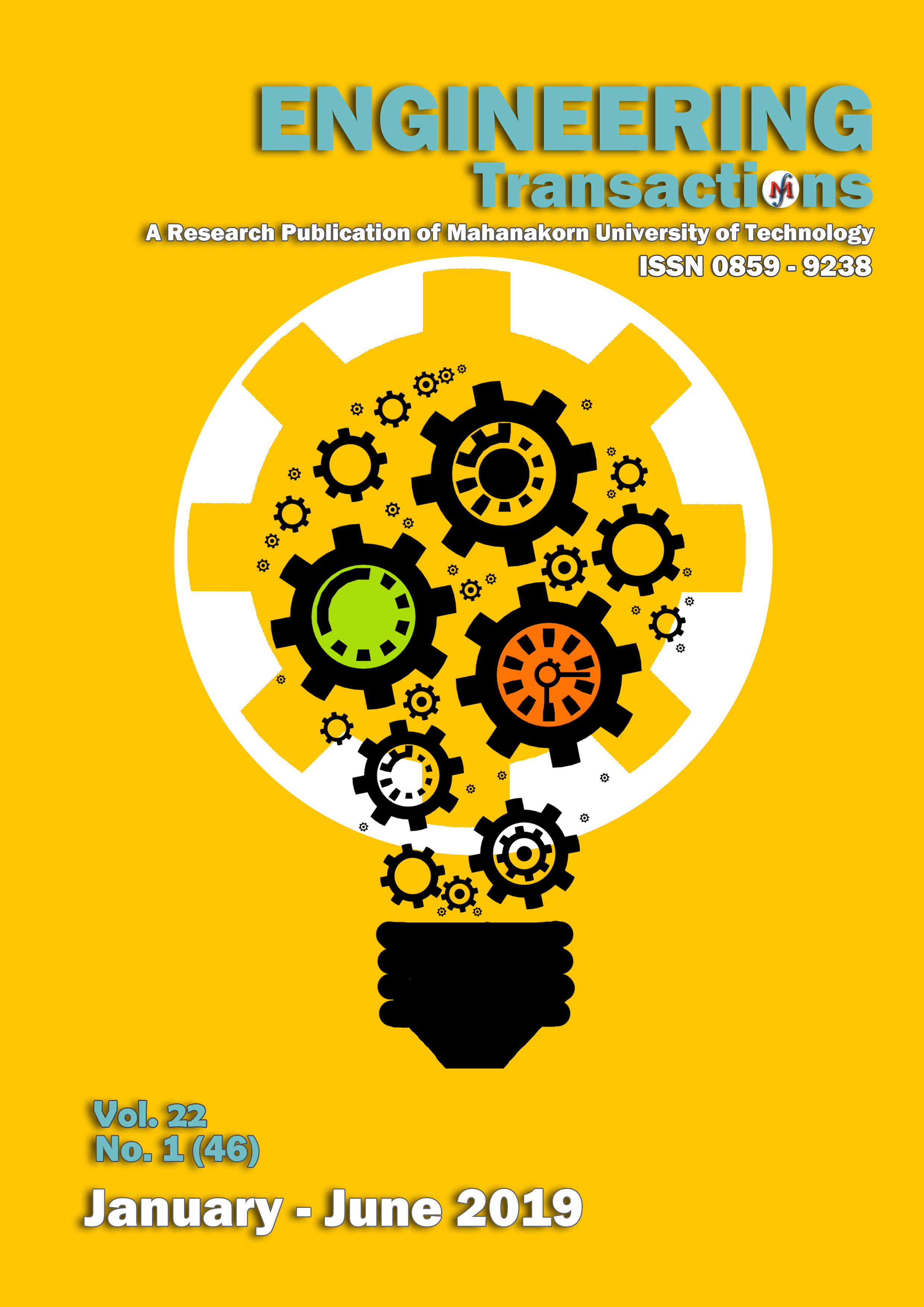Photocatalytic Degradation of Ethylene by TiO2/WO3 on Electrospun Silk Nanofiber
Main Article Content
Abstract
Anthropogenic ethylene at high concentrations in air is considered to be one of pollutant sources while the low concentration of ethylene naturally releasing from respiration in fruit could play an important role in the repining. Controlling ethylene concentration in active packaging by photocatalytic reactions is an alternative way to prolong shelf-life after harvesting. This research aims to develop the electrospun nanofiber from silk fibroin as a support. Several electrospinning parameters were controlled by applied high voltage of 30 kV, the distance between the needle and the collector of 8 cm and the flow rate of fibroin solution at 4 ml/h. The as-prepared electrospun fiber were coated with TiO2 and WO3 with 2 different patterns; TiO2 coated on WO3 immobilized on fiber (TiO2/WO3) and vice versa (WO3/TiO2). Moreover, the effect of TiO2:WO3 mole ratios (1:0.4 to 1:1.1) on ethylene removal from humid air with the initial ethylene concentration of 40 ppm were also investigated. The results show that TiO2/WO3 exhibited ethylene removal 1-1.5 times higher than WO3/TiO2 at mole ratios of 1:0.7 and 1:1.1. This higher efficiency may attribute to the charge separation effect resulting from synergetic effect of TiO2 and WO3, which can cause photo-excited holes to transfer to the surface of TiO2 and further reacted with water to form hydroxyl radical. The radicals initially induced decomposition of ethylene to CO2 and water. Furthermore, TiO2/WO3 at mole ratio of 1:0.7 showed the excellent ability to remove ethylene of 22.13 mmolC2H4/molTiO2 which is 1.4-times higher than that of TiO2 while WO3 could not remove ethylene. This emphasized the charge separation could be enhanced the photocatalytic efficiency.
Article Details
Copyright @2021 Engineering Transactions
Faculty of Engineering and Technology
Mahanakorn University of Technology
References
Government of Canada. (2016). Environment and Climate Change Canada Health Canada. 14 April 2562, Retrieved from https://www.ec.gc.ca/ese-ees/default.asp?lang=En&n=0C828850-1
กรมควบคุมมลพิษ. (2561). ทำเนียบการปลดปล่อยและเคลื่อนย้ายมลพิษ. สืบค้นเมื่อ 13 เมษายน 2562, เข้าถึงได้จาก http://prtr.pcd.go.th.
Kader, A. A. (1985). Ethylene-induced senescence and physiological disorders in harvested horticultural crops. Hort Science, 1, 54-57
Zhu, Z., Zhang, Y., Shang, Y and Wen, Y. (2019). Electrospun nanofibers containing TiO2 for the degradation of ethylene and delaying postharvest ripening of bananas. Food and Bioprocess Technology, 12(2), 281-287.
Mitrovi Chen, Z., Zhao, J., Yang, X., Ye, Huang, K., Hou, C and Li, Y. (2015). Fabrication of TiO2/WO3 composite nanofibers by electrospinning and photocatalytic performance of the resultant fabrics. Industrial & Engineering Chemistry Research, 55(1), 80-85.
ชลิตา นิ่มนวล. 2561. การพัฒนาฟิล์มถนอมอาหารหารด้วยอนุภาคโลหะออกไซด์ขนานนาโน. วิทยานิพนธ์าวิศวกรรมศาสตร์มหาบัณฑิต, สาขาวิชาวิศวกรรมเคมี, วิศวกรรมศาสตร์, มหาวิทยาลัยบูรพา.
DeBari, M. K and Abbott, R. D. (2019). Wiley Interdisciplinary Reviews: Nanomedicine and Nanobiotechnology, 11(2), e1534.
ณัฐวุฒิ ภูกิ่งนา และธนาคม นุอ่อน. 2559. การกำจัดโทลูอีนด้วยปฏิกิริยาโฟโตแคตะไลติกของ TiO2/WO3 บนตัวรองรับเส้นใยไหม. ปริญญาวิศวกรรมศาสตรบัณฑิต, สาขาวิชาวิศวกรรมเคมี, วิศวกรรมศาสตร์, มหาวิทยาลัยบูรพา.
ฝ่ายเศรฐกิจและศูนย์ข้อมูล หอการค้าไทย. (2560). การส่งออกสิ่งทอปี 60. สืบค้นเมื่อ 18 เมษายน 2562, เข้าถึงได้จาก
https://www.thaichamber.org/content/file/document/0830171504065087.pdf
Kishimoto, Y., Morikawa, H., Yamanaka, S and Tamada, Y. (2017). Electrospinning of silk fibroin from all aqueous solution at low concentration. Materials Science and Engineering: C, 73, 498-506.
Tasaso, A and Ngaotrakanwiwat, P. (2015). Synthesis of Nano-WO3 Particles with Polyethylene Glycol for Chromic Film. Energy Procedia, 79, 704-709.
Guayaquil-Sosa, J. F., Serrano-Rosales, B., Valadés-Pelayo, P. J and De Lasa, H. (2017). Photocatalytic hydrogen production using mesoporous TiO2 doped with Pt. Applied Catalysis B: Environmental, 211, 337-348.
Choi, T., Kim, J. S and Kim, J. H. (2016). Transparent nitrogen doped TiO2/WO3 composite films for self-cleaning glass applications with improved photodegradation activity. Advanced Powder Technology, 27(2), 347-353.
Zhang, L., Qin, M., Yu, W., Zhang, Q., Xie, H., Sun, Z and Guo, Z. (2017). Heterostructured TiO2/WO3 nanocomposites for photocatalytic degradation of toluene under visible light. Journal of The Electrochemical Society, 164(14), H1086-H1090.


